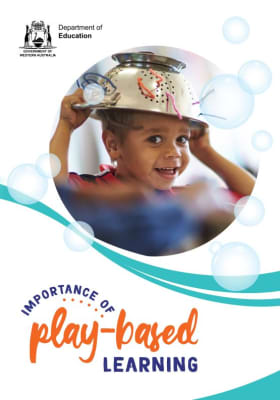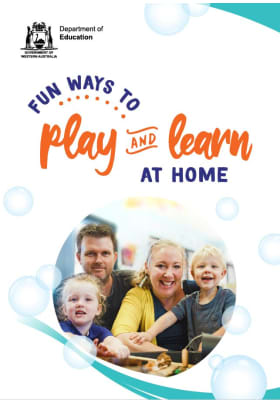Play-based learning
Play-based learning
Your child is naturally curious. Right from birth, they are wondering and exploring.
They are watching and listening. Moving and feeling. The daily interactions and experiences you share with your children is how they learn about the world around them. These interactions involve play.
Play is a powerful and important activity. It has a natural and positive influence on children’s social, physical, emotional and cognitive development. The best learning happens when children play. It is important to let your children play every day.
Children will find many things to play with inside and outside the home, and in parks and playgrounds. Being with your child and seeing what they are doing will give you ideas about the things they like to play with. All you need is imagination!
Whether it is playing dress ups, constructing grand designs with building blocks, singing songs, telling stories, playing with containers or having fun outside with sand and water – play can be built into everyday routines and activities. Let your children see you having fun!
Public schools are fantastic places for children to learn through play. A play-based learning environment encourages talking, reading, thinking and writing. Through this, your child sees literacy and numeracy as part of their everyday experience.
Play along with them and you will be amazed at what you can learn together!
Discover more about the types of play-based learning and how you can incorporate play at home.
- Growing and learning through play
- Support your child to learn through play
- Schools support your child’s development through play
- Activities you can do at home with your child
- More information about play
Your child is naturally curious. They want to know about the world around them. They do this by watching, listening, moving, talking, feeling, exploring and questioning. These interactions and experiences often involve play.
Through play, children can discover their own interests, abilities and limitations; they imagine, investigate and explore. They develop memory skills, build vocabulary, learn new skills and knowledge and learn how to get on with adults and other children.
Play is an essential part of childhood and is the natural way children learn. When children play, they:
- socialise
- think creatively
- negotiate
- notice new things
- repeat favourite things
- overcome barriers.
Research shows that learning through play supports positive attitudes towards learning, providing a good foundation for ongoing success at school and skills for life-long learning.
Play also supports the development of both large and small types of movement. Large movements include running, jumping, hopping, climbing and balancing, while little movements use smaller muscles of the hands and fingers such as drawing, picking up, stacking, manipulating and experimenting with objects. These fine motor skills are what we use every day for doing up zips and buttons, using cutlery and opening up containers.
You can support your child to learn by creating opportunities for them to play. Imaginative, spontaneous, unstructured play at home supports a child’s development and provides lots of things to talk about with your child.
Children need the opportunity to play, explore, be curious and creative. You can give your child the opportunity to create their own learning experiences, provide them with play options, let them decide what to play, and how long they will engage in it.
Schools are fantastic places for children to learn through play.
A play-based learning environment encourages talking, reading, writing and thinking.
The staff at your child’s school will use a variety of strategies to help your child learn skills and understand concepts. These may be explicitly taught, with play incorporated to reinforce and practise them.
Play builds on your child’s curiosity and allows them to experiment, question, discover and problem-solve. When children are playing they are trying new things, taking safe risks and trusting their own decisions.
For example, by playing with a range of objects in water, children learn that some things sink while others float. Children may even begin to understand why – especially when an adult is nearby asking questions that prompt them to think about what is happening and why. In the same activity, your child may use or hear some new words, group rules may be agreed (to make sure everyone does not get wet!), and concepts of mass, density, volume and fluidity can be talked about.
There are a range of play-based activities you can do with your child.
For some ideas on how you can play every day, see our Fun Ways to Play and Learn at Home.
A great starting point to find out more about play-based learning is to speak to your child’s teacher.
For other resources and activities visit:
Asset Publisher
-

The importance of play-based learning
Play is an essential part of every child's learning. This flyer for parents shows you how to support your child's learning through play.
-

Fun ways to play and learn at home
Many of our favourite childhood memories were made playing, whether it was building a fort with cushions, playing in the backyard, telling stories or dress-ups.
-

Learning through play at home
Children are born naturally curious and ready to learn. Play is the natural way children develop ideas and learn skills.